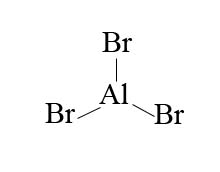


 علم الكيمياء
علم الكيمياء 
 الكيمياء التحليلية
الكيمياء التحليلية 
 الكيمياء الحياتية
الكيمياء الحياتية 
 الكيمياء العضوية
الكيمياء العضوية 
 الكيمياء الفيزيائية
الكيمياء الفيزيائية
 الكيمياء اللاعضوية
الكيمياء اللاعضوية 
 مواضيع اخرى في الكيمياء
مواضيع اخرى في الكيمياء
 الكيمياء الصناعية
الكيمياء الصناعية |
Read More
Date: 23-1-2020
Date: 22-10-2019
Date: 12-7-2018
|
(where X= Br or Cl, we will discuss further in detail later why other members of the halogen family Flourine and Iodine are not used in halogenation of benzenes)
.jpg?revision=1&size=bestfit&width=272&height=170)
Hence, Halogen needs the help and aid of Lewis Acidic Catalysts to activate it to become a very strong electrophile. Examples of these activated halogens are Ferric Hallides (FeX3) Aluminum Halides (AlX3) where X= Br or Cl. In the following examples, the halogen we will look at is Bromine.
In the example of bromine, in order to make bromine electrophillic enough to react with benzene, we use the aid of an aluminum halide such as aluminum bromide.

With aluminum bromide as a Lewis acid, we can mix Br2 with AlBr3 to give us Br+. The presence of Br+ is a much better electrophile than Br2 alone. Bromination is acheived with the help of AlBr3 (Lewis acid catalysts) as it polarizes the Br-Br bond. The polarization causes polarization causes the bromine atoms within the Br-Br bond to become more electrophillic. The presence of Br+ compared to Br2 alone is a much better electrophille that can then react with benzene.
.jpg?revision=1&size=bestfit&width=639&height=214)
As the bromine has now become more electrophillic after activation of a catalyst, an electrophillic attack by the benzene occurs at the terminal bromine of Br-Br-AlBr3. This allows the other bromine atom to leave with the AlBr3 as a good leaving group, AlBr4-.
.jpg?revision=1&size=bestfit&width=406&height=203)
.jpg?revision=1&size=bestfit&width=482&height=283)
After the electrophilic attack of bromide to the benzene, the hydrogen on the same carbon as bromine substitutes the carbocation in which resulted from the attack. Hence it being an electrophilic aromatic SUBSTITUTION. Since the by-product aluminum tetrabromide is a strong nucleophile, it pulls of a proton from the Hydrogen on the same carbon as bromine.
.jpg?revision=1&size=bestfit&width=481&height=224)
In the end, AlBr3was not consumed by the reaction and is regenerated. It serves as our catalyst in the halogenation of benzenes.



|
|
|
|
"عادة ليلية" قد تكون المفتاح للوقاية من الخرف
|
|
|
|
|
|
|
ممتص الصدمات: طريقة عمله وأهميته وأبرز علامات تلفه
|
|
|
|
|
|
|
الأمين العام للعتبة العسكرية المقدسة يستقبل شيوخ ووجهاء عشيرة البو بدري في مدينة سامراء
|
|
|